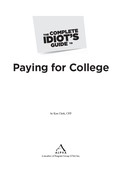The First Assets to Go
There’s a recipe, if you will, for which assets should ideally be tapped first to help pay for college. While your unique situation may not include some of these asset groups or may require you to slightly reorder their liquidation, the general principles remain the same. You want to get rid of the following assets first:
• Aid-reducing assets—Different assets, as well as who owns those assets, have varying effects on your financial aid package. In short, assets owned by your child lower your aid package the most and should be the first to go. Assets owned in the parents’ names count against aid, but not as much as a child’s assets, and should go next. Assets owned by extended family members (grandparents) and certain protected assets (such as retirement plans and insurance) won’t likely lower your aid at all and should probably be held onto as long as possible.
• Low tax assets—Investments and assets that can be accessed without paying any tax should be considered for liquidation before those that will incur a large tax bill.
• Low liquidation costs—Some investments, especially if sold in a hurry, can experience a substantial decrease in their value. Assets that meet the other criteria, but are also low on liquidation costs, should be moved to the front of the line.

CHEAT SHEET
One of the best ways to minimize the tax costs associated with liquidating an investment is to make sure you time the sale to land in either this year or the next, depending when your overall tax bracket will be lower. Sometimes it even makes sense to sell part of an investment now and part of it in the coming year to minimize the taxes associated with it. Because the savings can easily equate to 5 to 10 percent of an asset’s value, talk to a tax professional if you expect your taxable income to fluctuate significantly in the coming years.
In addition to these characteristics that make assets more preferential to tap early on in the college experience, other characteristics indicate an asset should not be tapped if possible. In particular:
• Reserved for other goals—If you have assets set aside for other goals, especially retirement, you should avoid tapping them as long as possible. Liquidating these assets to meet college costs simply creates a new problem while solving another.
• Asset-based borrowing—If you have an asset that is worth a significant amount of money, you should generally avoid using it as collateral to secure a loan. This is especially true if the asset is the roof over your head, the car you drive, or the business that puts bread on your table.
• Superior rate of return—Assets that have a proven potential for growth or income should not be used if you can borrow money (especially from Uncle Sam) at rates that are below what you’re earning. By borrowing at a cheaper rate and earning at a higher rate, you get to keep the difference in income and the asset.
..................Content has been hidden....................
You can't read the all page of ebook, please click here login for view all page.
